Security risks for civil aviation in South Sudan are likely to be low over the coming years.
This assessment was issued to clients of Dragonfly’s Security Intelligence & Analysis Service (SIAS) on 17 July 2024.
- This primarily stems from a lack of professionalism by the local military; in 2012 it shot down a UN helicopter that it misidentified as an ‘enemy plane’
- The authorities also seem to be unable to effectively manage ATC for overflights at cruising altitudes
Security risks for civil aviation in South Sudan are likely to be low over the coming years. The lack of air traffic control (ATC) at cruising altitudes will probably be the main cause of operational disruption. That said, we assess that low-flying aircraft would be at risk of misidentification in the event that countrywide fighting resumes between President Salva Kiir and his longtime rival, Riek Machar. The government warned in 2023 that it would ‘shoot down’ illegal aircraft. But in our view, this threat is aimed at small smuggling aircraft and is unlikely to affect commercial airlines.
Widespread armed fighting has largely subsided after Kiir and Machar signed a peace deal in 2018. And other small armed militias that remain active across the country at present do not seem to have the intent nor the capability to target civil aircraft, especially at high altitudes. Signalling this, several international airlines currently operate in South Sudan and overfly the country. Some European aviation regulators do advise caution at altitudes below FL260 (26,000ft). We suspect this is over concerns that the fragile peace deal could collapse at short notice.
Lack of ATC at cruising altitudes
The primary source of disruption to civil aviation operations currently stems from poor airspace management. Due to the lack of capabilities, the authorities signed an agreement with Sudan in 2016 handing over ATC in its airspace. But armed fighting that broke out in Sudan in April 2023 means there is currently no ATC above FL245. The South Sudanese aviation authority also continues to advise aircraft to ‘use Traffic Collision Avoidance System (TCAS) since [their] radio cannot cover the whole of South Sudan’. President Kiir said in April the country is ‘close’ to reclaiming control of the airspace but he did not specify the date for this.
Low risk of misidentification for low-flying aircraft
We assess there is a low risk of misidentification by the military across South Sudan. The army appears to lack professionalism; it has previously faced command and control issues linked to poor communications, training and safeguards. In 2012, the military misidentified and shot down a UN helicopter used for peacekeeping operations. A military spokesperson said at the time it believed it was an ‘enemy plane’. But we are not aware of any similar incidents since. This is even though we have seen few indications that the military has since significantly improved its professionalism.
Despite the cessation of fighting, a directive issued by the military in June 2023 to ‘shoot down’ aircraft that enter its airspace ‘illegally’ is indicative of a continued risk of misidentification. We are not aware of the military doing so since. In our analysis, this order is most likely aimed at smaller aircraft engaged in smuggling activities rather than commercial aviation. The military issued a similar warning in 2015 when it reportedly said that planes and helicopters had landed ‘without the knowledge of the government’ to deliver weapons to local armed groups.
The risk of misidentification is likely to be most acute for aircraft landing and taking off. Western aviation regulators do not advise of such risks for overflights at cruising altitudes. The military possesses S-125 surface-to-air missiles capable of reaching up to 82,000ft since at least 2013, based on local media reporting. But there is no armed fighting ongoing in the country that would mandate the use of such weapons.
Collapse of peace deal would heighten misidentification risks
The risk of misidentification for low-flying aircraft by the armed opposition forces (SPLM-IO) would very likely become high should the peace deal collapse. The SPLM-IO is not currently intent on targeting civilian aviation, in our assessment. But the peace agreement between Kiir and Machar remains fragile and its collapse is probable over the coming years. Kiir appears to want to continue undermining his rival by taking unilateral action to diminish the latter’s influence.
SPLM-IO forces have previously targeted aircraft that they perceive as aiding government troops. In 2013, the US military said three of its aircraft were shot at near Bor (held by troops loyal to Machar) during the evacuation of US citizens there. Still, we suspect the group would only be able to target aircraft landing and taking off. Local press reported in 2014 that SPLM-IO forces have access to QW-18 MANPADS capable of reaching aircraft up to 4,000m (13,123ft). We have not seen evidence to suggest that they have weapons capable of targeting aircraft at higher altitudes.
Armed militia pose low risk to civilian aircraft
Other communal militias still active in South Sudan have also not shown intent to target civil aviation. Such groups usually mount armed attacks and raids against rival communities to gain control of land and resources. And their capabilities are mostly limited to small firearms, machine guns and launchers (such as RPGs), based on publicly reported weapons seizures in recent years. However, none of these militias have threatened civilian aircraft in recent years. Nor do we assess that any of them perceive it as being in their interest to do so.
Image: A man walks in front of the departure gate of the new terminal building at Juba International Airport in Juba, South Sudan, on 29 October 2018. Photo by Akuot Chol/AFP via Getty Images.




